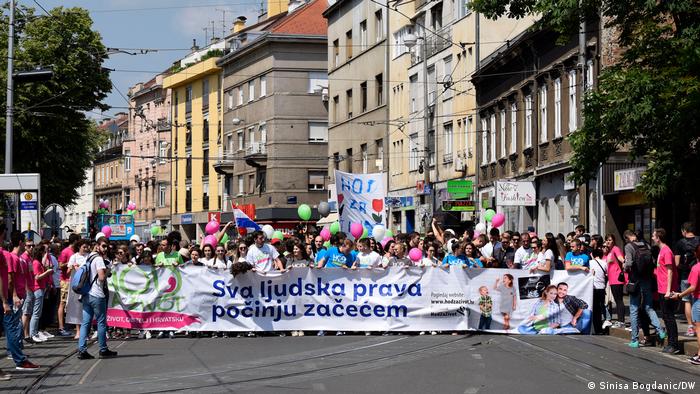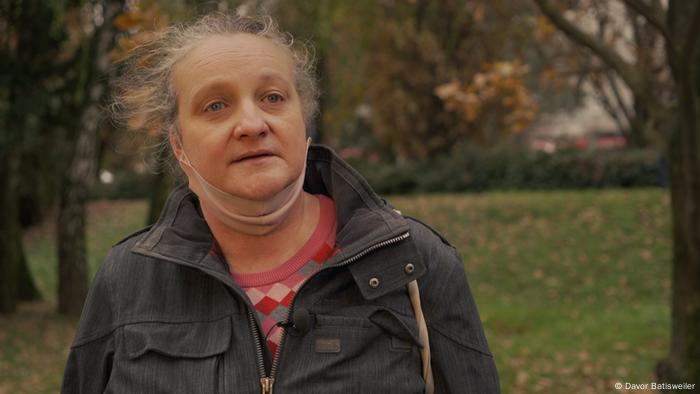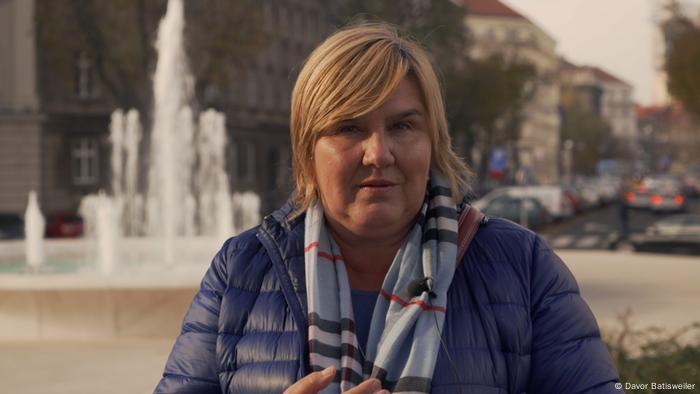The Iraqi city of Mosul was captured by the Islamic State group in 2014.
Much of its cultural heritage was destroyed during the occupation.
Three year's after Mosul's liberation, the city is now being rebuilt.

Locals hope rebuilding the city's cultural artifacts will foster a new solidarity
In the summer of 2014, the Islamic State group (IS) conquered Iraq's second largest city of Mosul. It was here in June that same year that the organization's then-leader, Abu Bakr al-Baghadi, proclaimed an Islamic Caliphate.
In late 2016, Iraqi, US, Kurdish Peshmerga and other ground forces — backed by an international anti-IS air force — launched a campaign to retake the northern Iraqi city. After nine months of fierce fighting, the coalition succeeded in driving IS forces from the heavily fortified city. In July 2017, Iraq's then-prime minister, Haider al-Abadi, was able to declare Mosul's liberation.
The people of Mosul suffered greatly during the brutal IS reign. Hundreds of young men who refused to join the militant group were executed. Locals were used as human shields during the campaign to retake the city. According to the UN, over 5,000 families were abducted for this purpose.
IS sought to wipe out Mosul's cultural heritage
During the occupation, IS destroyed shrines, church statues and tombs, and ripped crosses from Church roofs. The militants also tore down bell towers and altar domes.
IS set churches ablaze, and blew up Shiite mosques and Sufi shrines. The extremists even set out to erase vestiges of Mosul's ancient past. What little that was spared was later destroyed in the battle to retake the city.

The Grand al-Nuri Mosque was one of the many historic sites destroyed in Mosul
The extremists wanted to erase northern Iraq's cultural legacy, archaeologist Richard R. Zettler of the University of Pennsylvaniatold DW. He is in charge of the Iraq Heritage Stabilization Program, which brings together the Iraqi government and various civil society groups in an effort to rebuild Mosul's historic architecture. The initiative is supported by Germany's Gerda Henkel Foundation.
"The people of Mosul and the surrounding towns feel a strong connection to their region's heritage," says Zettler. Nineveh, the most important city of the Assyrian empire, was located where Mosul is situated today. "Mosul residents are very proud to be descents of the Assyrian kings, who ruled over much of the Middle East in the first millennium before Christ," says Zettler. "IS did everything it could to wipe out whatever traces of this ancient past were still visible in the region."
IS also persecuted ethnic and religious minorities, thereby aggravating tensions among different social groups within Mosul, says political scientist Irene Costantini, who teaches at Bologna University. With support from the Gerda Henkel Foundation, Costantini is researching what rebuilding Mosul means from a sociological and political perspective.
She says different minorities in Mosul formed armed groups in response to IS' reign of terror. "Instead of contributing to a greater sense of security, locals perceived this as a further source of insecurity," the researcher says.
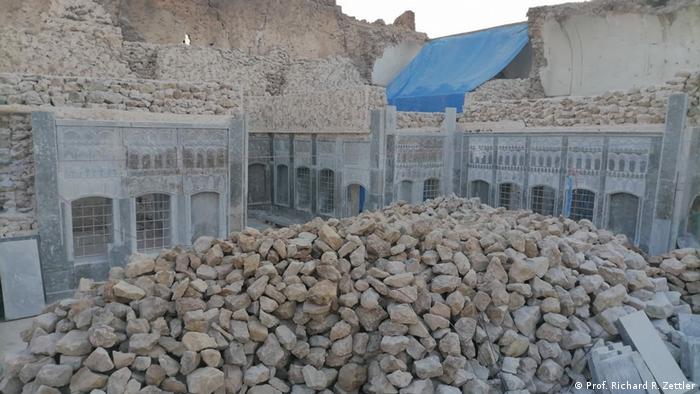
The Iraq Heritage Stabilization Program aims to rebuild Mosul's historic architecture
Transitional justice and a program of national reconciliation are now needed to restore trust within Iraqi society, says Constantini. But, she adds, "these are long term processes that depend on the continued support of local and national political decision-makers."
Rebuilding and repairing cultural heritage sites will play an important role in this context. Doing so will help restore locals' sense of identity. There is also hope that joining forces to rebuild what was wiped out can also help bring different societal groups together and forge a shared consciousness of the pain endured under IS rule. This is a key condition for coming together and, hopefully, fostering a new, shared identity.
Restoration efforts no longer a political priority
Many of the region's historic edifices can be rebuilt, says Zettler. "It is possible to restore or rebuild Mosul's mosques, churches, shrines, historic houses, gates and city walls." But the archaeologist says that rebuilding churches in Mosul's old city center will have symbolic significance only. "Only very few Christians driven from the city will return."
Costantini says that efforts to rebuild and restore cultural sites are no longer at the top of the country's political agenda. The researcher says undoing damage wrought by IS in the entire area once under its control would cost an estimated $88 billion (€73 billion) — much more money than currently pledged by authorities.
As Iraq faces an ongoing governmental and economic crisis — not to mention the coronavirus pandemic — restoring its cultural heritage is no longer a top priority, says Costantini.
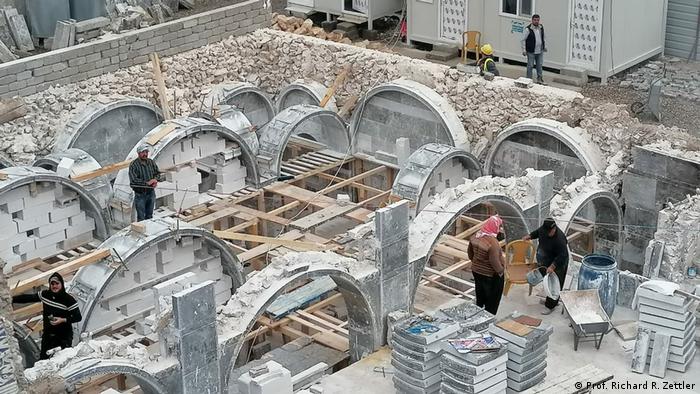
Rebuilding Mosul will take much time and patience
Despite all this, Mosul residents are supporting the reconstruction efforts. "Cooperation with people in Mosul and surrounding towns is great," says Zettler. Nevertheless, conditions are difficult, as locals inhabit a largely destroyed city in which there is a lack of residential and public buildings.
"They are enthusiastic about reconquering their historic and cultural heritage," says Zettler. "They see both as decisive for their future and are happy for the employment opportunities provided by these restoration efforts." He says the initiative has several effective partners on the ground. "Without them, we could hardly make this happen."
This article was translated from German.

Locals hope rebuilding the city's cultural artifacts will foster a new solidarity
In the summer of 2014, the Islamic State group (IS) conquered Iraq's second largest city of Mosul. It was here in June that same year that the organization's then-leader, Abu Bakr al-Baghadi, proclaimed an Islamic Caliphate.
In late 2016, Iraqi, US, Kurdish Peshmerga and other ground forces — backed by an international anti-IS air force — launched a campaign to retake the northern Iraqi city. After nine months of fierce fighting, the coalition succeeded in driving IS forces from the heavily fortified city. In July 2017, Iraq's then-prime minister, Haider al-Abadi, was able to declare Mosul's liberation.
The people of Mosul suffered greatly during the brutal IS reign. Hundreds of young men who refused to join the militant group were executed. Locals were used as human shields during the campaign to retake the city. According to the UN, over 5,000 families were abducted for this purpose.
IS sought to wipe out Mosul's cultural heritage
During the occupation, IS destroyed shrines, church statues and tombs, and ripped crosses from Church roofs. The militants also tore down bell towers and altar domes.
IS set churches ablaze, and blew up Shiite mosques and Sufi shrines. The extremists even set out to erase vestiges of Mosul's ancient past. What little that was spared was later destroyed in the battle to retake the city.

The Grand al-Nuri Mosque was one of the many historic sites destroyed in Mosul
The extremists wanted to erase northern Iraq's cultural legacy, archaeologist Richard R. Zettler of the University of Pennsylvaniatold DW. He is in charge of the Iraq Heritage Stabilization Program, which brings together the Iraqi government and various civil society groups in an effort to rebuild Mosul's historic architecture. The initiative is supported by Germany's Gerda Henkel Foundation.
"The people of Mosul and the surrounding towns feel a strong connection to their region's heritage," says Zettler. Nineveh, the most important city of the Assyrian empire, was located where Mosul is situated today. "Mosul residents are very proud to be descents of the Assyrian kings, who ruled over much of the Middle East in the first millennium before Christ," says Zettler. "IS did everything it could to wipe out whatever traces of this ancient past were still visible in the region."
IS also persecuted ethnic and religious minorities, thereby aggravating tensions among different social groups within Mosul, says political scientist Irene Costantini, who teaches at Bologna University. With support from the Gerda Henkel Foundation, Costantini is researching what rebuilding Mosul means from a sociological and political perspective.
She says different minorities in Mosul formed armed groups in response to IS' reign of terror. "Instead of contributing to a greater sense of security, locals perceived this as a further source of insecurity," the researcher says.

The Iraq Heritage Stabilization Program aims to rebuild Mosul's historic architecture
Transitional justice and a program of national reconciliation are now needed to restore trust within Iraqi society, says Constantini. But, she adds, "these are long term processes that depend on the continued support of local and national political decision-makers."
Rebuilding and repairing cultural heritage sites will play an important role in this context. Doing so will help restore locals' sense of identity. There is also hope that joining forces to rebuild what was wiped out can also help bring different societal groups together and forge a shared consciousness of the pain endured under IS rule. This is a key condition for coming together and, hopefully, fostering a new, shared identity.
Restoration efforts no longer a political priority
Many of the region's historic edifices can be rebuilt, says Zettler. "It is possible to restore or rebuild Mosul's mosques, churches, shrines, historic houses, gates and city walls." But the archaeologist says that rebuilding churches in Mosul's old city center will have symbolic significance only. "Only very few Christians driven from the city will return."
Costantini says that efforts to rebuild and restore cultural sites are no longer at the top of the country's political agenda. The researcher says undoing damage wrought by IS in the entire area once under its control would cost an estimated $88 billion (€73 billion) — much more money than currently pledged by authorities.
As Iraq faces an ongoing governmental and economic crisis — not to mention the coronavirus pandemic — restoring its cultural heritage is no longer a top priority, says Costantini.

Rebuilding Mosul will take much time and patience
Despite all this, Mosul residents are supporting the reconstruction efforts. "Cooperation with people in Mosul and surrounding towns is great," says Zettler. Nevertheless, conditions are difficult, as locals inhabit a largely destroyed city in which there is a lack of residential and public buildings.
"They are enthusiastic about reconquering their historic and cultural heritage," says Zettler. "They see both as decisive for their future and are happy for the employment opportunities provided by these restoration efforts." He says the initiative has several effective partners on the ground. "Without them, we could hardly make this happen."
This article was translated from German.



